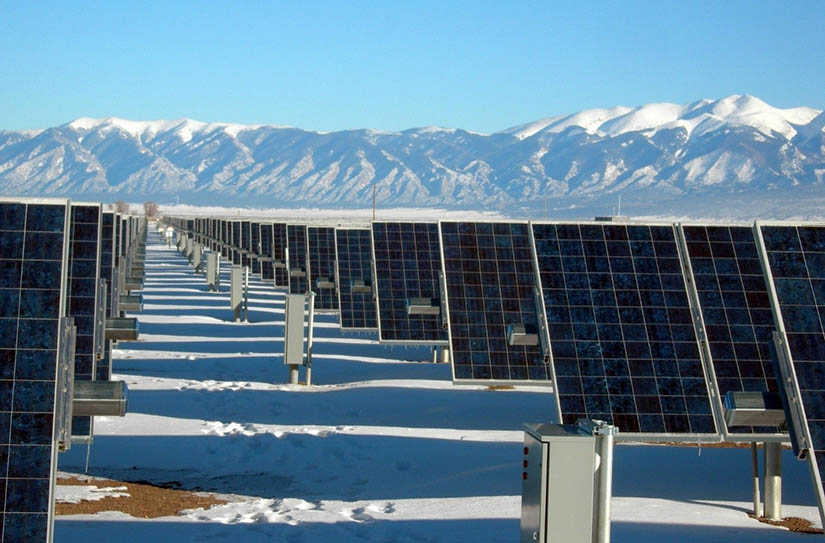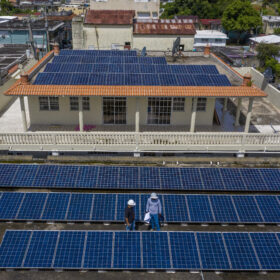Photovoltaics were by far the world’s leading power-generating technology installed in 2019; 45% of capacity added was solar with one third of all countries making it their top choice. Solar power become the leading new power-generating source in the world, besting wind and hydro to overtake coal in global installed capacity, according to the analysis by research consultancy BloombergNEF. PV added 118 GW of new plant in 2019 on its way to reaching 651 GW of capacity, outpacing wind’s total 644 GW, to become the fourth largest power source on the planet, behind coal’s 2.1 TW, gas’ 1.8 TW and hydro’s 1.2 TW. Solar and wind together accounted for 67% of new capacity added globally in 2019, while fossil fuels slide to 25%, according to BNEF’s new Power Transition Trends 2020 report. Source: BNEF
Appalachian solar effort a reality after backers powered through setbacks: A new initiative announced Wednesday will install up to 12 MW of solar power in Virginia’s historic coalfield region over the next three years. Persistence should be Adam Wells’ middle name. The nonprofit organizer’s vision of embedding solar energy training, jobs and renewable power in his native Appalachia is on the verge of happening after five-plus years of brainstorming, cajoling and striving. A new initiative announced Wednesday, called Securing Solar for Southwest Virginia, will deliver on Wells’ dogged pursuit of affordable solar power for businesses, nonprofits and local governments in the state’s seven-county historic coalfield region. Private and public partners involved in the ambitious undertaking plan to install up to 12 megawatts of solar power in the next three years while also creating 15 full-time jobs in solar installation, sales and marketing, entrepreneurship, and small business development. Source: Energy News Network
Community solar proposal getting bipartisan support in Pennsylvania legislature: Energy issues in Pennsylvania can be fiercely partisan, but a measure in the state legislature to encourage clean energy development is gaining support on both sides of the aisle. The measure allows for community solar projects, which are larger than home rooftop panels but smaller than utility-scale grids. The behind-the-meter projects are owned by solar developers. The energy generated is shared by a group of subscribers who get a credit on their electricity bills for what they use. The projects can remove barriers to solar power, such as up-front cost or homeownership, according to Leslie Elder with the Coalition for Community Solar Access. The bill’s sponsor, Rep. Aaron Kaufer (R-Luzerne), said over 200 potential projects in the state are just waiting for the legislature’s OK. Source: State Impact Pennsylvania
The U.S. Department of Energy announced $29 million in funding for 14 projects as part of the Advanced Research Projects Agency-Energy’s (ARPA-E) Galvanizing Advances in Market-aligned fusion for an Overabundance of Watts (GAMOW) program. Teams in this program will work to close multiple fusion-specific technological gaps that will be needed to connect a net-energy-gain “fusion core,” once it is ready, to a deployable, commercially attractive fusion system. “Fusion energy is a potentially game-changing clean energy source, but it has faced scientific and technical challenges for decades,” said ARPA-E Director Lane Genatowski. “GAMOW teams will work to further develop enabling fusion materials and subsystem technologies, with a focus on the timely future commercialization and deployment of fusion energy generation.” While recent investments have been made in the development of a viable and net-energy-gain fusion-energy system, there remains a significant need to focus on the materials and enabling technologies that will be needed to establish fusion energy’s technical and commercial viability once net energy gain is achieved. Source: DOE
This content is protected by copyright and may not be reused. If you want to cooperate with us and would like to reuse some of our content, please contact: editors@pv-magazine.com.







By submitting this form you agree to pv magazine using your data for the purposes of publishing your comment.
Your personal data will only be disclosed or otherwise transmitted to third parties for the purposes of spam filtering or if this is necessary for technical maintenance of the website. Any other transfer to third parties will not take place unless this is justified on the basis of applicable data protection regulations or if pv magazine is legally obliged to do so.
You may revoke this consent at any time with effect for the future, in which case your personal data will be deleted immediately. Otherwise, your data will be deleted if pv magazine has processed your request or the purpose of data storage is fulfilled.
Further information on data privacy can be found in our Data Protection Policy.